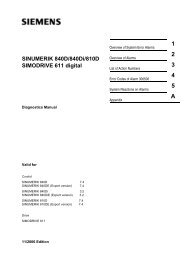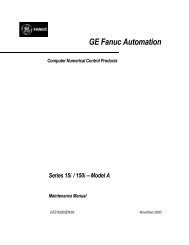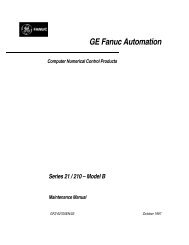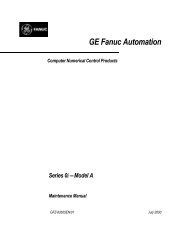15-B Maintenance Mnl, GFZ-62075E/03 - Automation Service Srl
15-B Maintenance Mnl, GFZ-62075E/03 - Automation Service Srl
15-B Maintenance Mnl, GFZ-62075E/03 - Automation Service Srl
You also want an ePaper? Increase the reach of your titles
YUMPU automatically turns print PDFs into web optimized ePapers that Google loves.
3. TROUBLESHOOTING AND ACTION TO BE TAKEN<br />
B–<strong>62075E</strong>/<strong>03</strong><br />
3.2.2 Action to be taken when an error code is displayed<br />
Item<br />
If the CNC system detects an error, it displays the corresponding error code and alarm message on the screen.<br />
The error codes and alarm messages are listed in the Operator’s Manual (Programming). For an explanation<br />
of servo alarms, refer to the relevant maintenance manual. Each servo alarm is described, together with the<br />
corresponding corrective action.<br />
The following covers important alarms and the actions to be taken.<br />
(1) PS200 PULSE CODER SYNCHRONOUS ERROR<br />
While returning to the reference position, either a one–rotation signal is not sent from the pulse coder or<br />
the signal is sent but the motion is too slow.<br />
When a pulse coder is employed, the reference counter is synchronized with the one–rotation signal the<br />
first time the machine returns to the reference position after the power is turned on or an emergency stop<br />
is reset. In this synchronization, the following conditions must be met so that the same edge of the one–<br />
rotation signal can be detected.<br />
(A) The positional deviation (diagnosis function No. 3000) must be at least 128.<br />
(B) One or more one–rotation signals must be sent after the positional deviation (diagnosis function No.<br />
3000) has been at least 128 (but before the deceleration dog is released again).<br />
The one–rotation signal is not used when the machine returns to the reference position the second<br />
or subsequent time. Thus, this alarm does not occur after the machine has returned to reference position<br />
the first time.<br />
Possible cause of the<br />
problem<br />
1 The feedrate is too slow.<br />
2<br />
3<br />
The position at which the<br />
machine starts returning to<br />
the reference position is<br />
too close to the reference<br />
position.<br />
The power supply voltage<br />
to the pulse coder is too<br />
low.<br />
How to check the cause<br />
Return the machine to the reference position<br />
under the same system conditions<br />
system as when the alarm occurred.<br />
Then, check the positional deviation<br />
(diagnostic data, parameter No.3000) using<br />
the self–diagnosis function and check<br />
that the deviation exceeds 128. In particular,<br />
carefully check the deviation when the<br />
machine returns to the reference position<br />
from the position at which the deceleration<br />
dog is pressed.<br />
Check the distance between the start<br />
position and the reference position.<br />
Check that the voltage through the pulse<br />
coder is 4.75V or above.<br />
To check the voltage through the<br />
pulse coder, remove the cover of<br />
the servo motor and measure the<br />
voltage between the positive and<br />
negative terminals on the printed<br />
circuit board of the pulse coder or<br />
between the land connected to<br />
the +5 V and the 0 V lines.<br />
Action to take<br />
Increase the feedrate.<br />
When the position gain is<br />
30sec –1 , the feedrate<br />
should be 300 mm/min or<br />
more.<br />
Use a start position whose<br />
distance from the reference<br />
position is equivalent<br />
to two or more motor rotations.<br />
The voltage drop through<br />
the cables must be 0.2V<br />
or less in total in both the<br />
5–V line and 0–V line.<br />
4<br />
5<br />
The pulse coder is defective<br />
The main CPU board or<br />
sub board is defective.<br />
Replace the pulse coder and check that<br />
the error is eliminated.<br />
Replace the printed circuit board to which<br />
the erroneous axis is connected, and<br />
check that the error is eliminated.<br />
Replace the pulse coder.<br />
Replace the pulse coder.<br />
– 18 –
















